In 1971, the Faculty of Science was officially founded as a separate entity from the Faculty of Arts. The general layout of the faculty closely resembles the one that we have today, with the notable exception of computer science, which joined the faculty in 1997. During this period, the boundaries between the different departments became more permeable as several interdisciplinary research institutes and programs were created. The student body also became much more international and diversified during this time. This period also marked the opening of the Faculty to the public with the Redpath Museum acting as the launching pad for several outreach initiatives that have importantly contributed to increased access to scientific knowledge beyond the walls of the institution.
In this period:
- A New Discipline – Computer Science
- Notable Faculty and Alumni
- The Venerable Redpath Museum Modernizes
- Gault Nature Reserve
- Science Outreach
- Interdisciplinary Approach, Global Reputation
A New Discipline – Computer Science
1958-2018

In 1958, the first computer arrived at McGill University. George Lee (John) d’Ombrain, the Chair of Electrical Engineering, oversaw this technological advancement and subsequently fostered the development of computer science in the 1960s. Before becoming a formal academic unit, graduate students studied computer science in the Faculty of Graduate Sciences since 1964. Then in 1969, the School of Computer Science was formally created under the Faculty of Engineering.
Computer engineering also evolved alongside but separately from the School of Computer Science. In fact, the term “school” was chosen to indicate independence from engineering. However, both departments often shared resources including space, academic appointments, and teaching assistants, which often left the School of Computer Science understaffed and underfunded. Engineers were also worried that a strong computer science program would draw students away from engineering, which caused each of the academic programs to develop uniquely.
Despite no dedicated undergraduate program for computer science yet, a Minor in Computer Science was introduced in 1978. This was followed by an undergraduate Honours program in 1979, but no Major program existed until the 1990s. The School of Computer Science introduced a new B.Sc. Major in Computer Science (in the Faculty of Science) in 1990, as well as a B.A. Major program in 1993. Finally, in 1997, following a heated debate between the Deans of the Faculty of Engineering and the Faculty of Science, the School of Computer Science became part of the Faculty of Science.
The school was originally housed in Burnside Hall, which was built in 1970 and contained the Computing Centre. In 1988, the School of Computer Science moved to the newly expanded and renovated McConnell Engineering Building, where it remains today. Following the $10 million donation of Lorne Trottier and the $7 million investment of the Quebec government, the Lorne M. Trottier building opened in 2003 to give both the School of Computer Science and the Department of Electrical and Computer Engineering greatly needed increased space and the latest high-tech equipment. Today, the building houses advanced teaching laboratories, interactive learning rooms, and meeting spaces.
Despite the slow and piecemeal academic development of computer science at McGill, the school has always been an innovative research hub and a leader in scientific advancement in Quebec and beyond. In 1984, McGill owned the two USENET nodes (an early form of online discussion boards, often used by academics) in Quebec, and in 1992, McGill was also the main network hub for all of Quebec’s academic networks. In 1985, four McGill professors formed McRCIM (the McGill Research Centre for Intelligent Machines), now known as the Centre for Intelligent Machines (CIM), to study intelligent systems. The CIM continues to be a collaborative interdisciplinary research centre with the goal of advancing the state of knowledge of robotics, automation, artificial intelligence, computer vision, systems and control theory, medical imaging, computer animation, speech recognition, and machine and reinforcement learning.
The school has a long list of alumni and professors with notable scientific contributions to society. Alan Emtage, a Master’s student in computer science at McGill, wrote the first internet search engine, Archie, in 1990 when he, Bill Heelan, and Peter Deutsch attempted to connect the university to the internet. In 1992, Emtage and Deutsch formed Bunyip Information Systems, the world’s first internet information services company.
This legacy of innovation continues into the present day as McGill’s School of Computer Science is the second-most funded computer science department in Canada. In the past decade, Montreal has become a global powerhouse in artificial intelligence, in part due to McGill’s strong faculty, students, and alumni, and McGill’s internationally-known Reasoning and Learning Lab. In 2017, two of its co-directors, Doina Precup and Joëlle Pineau received historic appointments in leading industry artificial intelligence labs. Precup was named head of Google-owned DeepMind in Montreal, and Pineau was named head of the Facebook AI Research Lab in Montreal. Both these ventures were the first Canadian AI labs launched by Google and Facebook.
Notable Faculty and Alumni
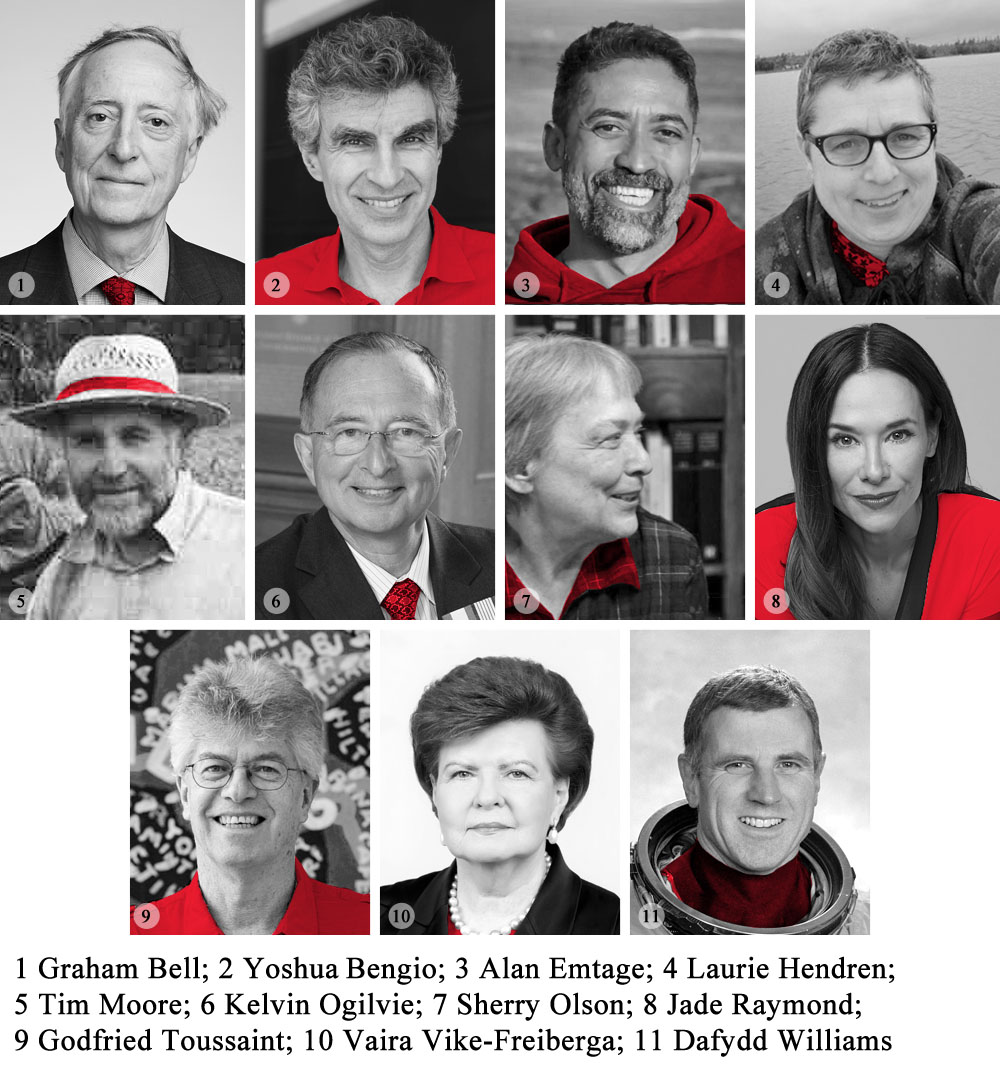
1971-present
After the 1970s, many graduates and faculty members continued the rich tradition of innovation and advancements within their scholarly pursuits at McGill. Here is a brief glimpse of some of the individuals that played a pioneering role within the Faculty of Science.
If there are additional graduates and faculty members that you would like to nominate to this list, contact us at timeline200.science@mcgill.ca.
Graham Bell has been an evolutionary biologist and professor at McGill since 1976. His most renowned contributions come from the field of experimental evolution, but he is equally well-recognized for his major influences on ecology and evolution, including the neutral biodiversity theory, which provides a simple and consistent explanation for large-scale ecological patterns such as the increase of species diversity with area, and the evolution of the main features of life cycles, such as sex and senescence.
Yoshua Bengio completed his B.Sc., M.Eng., and Ph.D. in Computer Science at McGill, and he is considered to be one of the world’s leading experts in artificial intelligence, artificial neural networks, and deep learning. Bengio currently acts as the Scientific Director of the Montreal Institute for Learning Algorithms, in 2016, he co-founded Element AI — a Montreal-based artificial intelligence incubator that turns AI research into real-world business applications. Bengio has received numerous awards for his significant contributions, including being appointed as an Officer of the Order of Canada and a Fellow of the Royal Society of Canada, and being awarded the Marie-Victorin Quebec Prize and the Turing Award.
Alan Emtage (1964 – )
Alan Emtage is a computer scientist and B.Sc. and M.Sc. alumnus of McGill in 1987 and 1991, respectively. Emtage conceived and implemented the first version of Archie, a pre-Web Internet search engine for locating material in public computer archives, and his work is widely considered the world’s first Internet search engine. He has chaired several working groups at the Internet Engineering Task Force, including one which established the standard for Uniform Resource Locators (URLs), and in 2017, he was inducted into the Internet Hall of Fame as an Innovator.
Laurie Hendren was a Canadian computer scientist and professor at McGill from 1990 until her passing in 2019. She also served as the Academic Associate Dean for the Faculty of Science from 2005 until 2014. Hendren developed new analytic methods for detecting aliasing and interference in programs manipulating pointer-based dynamic data structures, and worked on parallelizing compilers, aspect-oriented programming, and applications of program analysis to software engineering.
Tim Moore has been a physical geographer and professor at McGill since 1971. His research has focused on the relationships between soil and the environment, particularly the regulation of fluxes of gases, nutrients and elements between the soil and the atmosphere, the biosphere and the hydrosphere and the effect of human activities and climate and global change. Moore has applied his work at international study sites, including the wetlands and forested soils in Canada, the US, Panama, and New Zealand.
Kevin Ogilvie is a Canadian chemist and politician and was a professor at McGill from 1974 until 1987. Ogilvie is a leading expert on biotechnology, bioorganic chemistry, and genetic engineering, and his scientific accomplishments include the development of the chemistry of “Gene Machine”, an automated process for the manufacture of DNA, and the development of a general method for the chemical synthesis of large RNA molecules, which is still the basis for RNA synthesis worldwide.
Sherry Olson has been a historical geographer and professor at McGill since 1973. She has built her reputation on her pioneering work in public health, demography, and geographic information systems, and significantly advanced critical understandings of the environment, social, urban, and gender history in North America. Her most ambitious collective undertaking has been “MAP: Montréal l’avenir du passé”, a 20-year historical geographic information system project that brings together four-dimensional interactive maps of Montreal from 1881-1901.
Jade Raymond obtained a B.Sc. in Computer Science from McGill in 1998. After graduating, Raymond worked at Sony where she helped create Sony Online’s first Research Development Group. She then transferred her skills and expertise to Ubisoft Montreal in 2004, where she was a lead creator in the Assassin’s Creed game and later acted as Executive Producer on Assassin’s Creed II, to Electronic Arts in 2015, where she formed Motive Studios based out of Montreal, and to Google in 2019, leading Google’s first game studio called Stadia Games and Entertainment. She is one of the only few video game executives listed in Variety Magazine’s 500 Most Influential Business Leaders of 2018 who are shaping the global entertainment industry.
Godfried Toussaint (1944-2019)
Godfried Toussaint was a Canadian computer scientist and professor at McGill from 1972 until his retirement in 2007. Considered to be the father of computational geometry in Canada, Toussaint solved many fundamental and foundational questions in the field, such as presenting the first optimal algorithm to compute the diameter of a point set, developing the “Rotating Calipers” tool to solve a host of geometric problems, and efficiently triangulating a simple polygon or a set of points. He is also well known for his significant contributions to mathematical research in music, music information retrieval, information theory, and pattern recognition and analysis.
Vaira Vike-Freiberg is professor, scholar, public speaker, and politician who pursued a Ph.D. in Experimental Psychology from McGill in 1965. From 1965 to 1968, she worked in the Department of Psychology at the University of Montreal where she taught a wide range of subjects including pharmacology, psycholinguistics, scientific theories, experimental methods, language, and cognitive processes. Vike-Freiberg was elected for two presidential terms in Latvia, the first in 1999 and the second in 2003. During her leadership, she played a substantial role in incorporating Latvia into the European Union and NATO.
Dafydd Williams completed four degrees at McGill: a B.Sc. in Biology in 1976, an M.Sc. in Physiology in 1983, a Doctor of Medicine in 1983, and a Master of Surgery in 1983. Williams covered many bases in his numerous professions as a physician, public speaker, CEO, author, and retired Canadian Space Agency astronaut. In 2007, Williams was a Mission Specialist on two space flights — STS-90 and STS-118. During the 2007 mission, he did three spacewalks, making him the third Canadian to perform a spacewalk and set a record for total time on spacewalks, which totaled to 17 hours and 47 minutes. Williams was also the first non-American to have a senior management position with NASA as the Director of the Space and Life Sciences Directorate at Johnson Space Center and the Deputy Associate Administrator of the office of Spaceflight.
The Venerable Redpath Museum Modernizes
1882-Present
Over its almost 140 year history, although the Redpath Museum has undergone many changes, it has continued to be a centre of excellence in terms of research, teaching, and outreach.
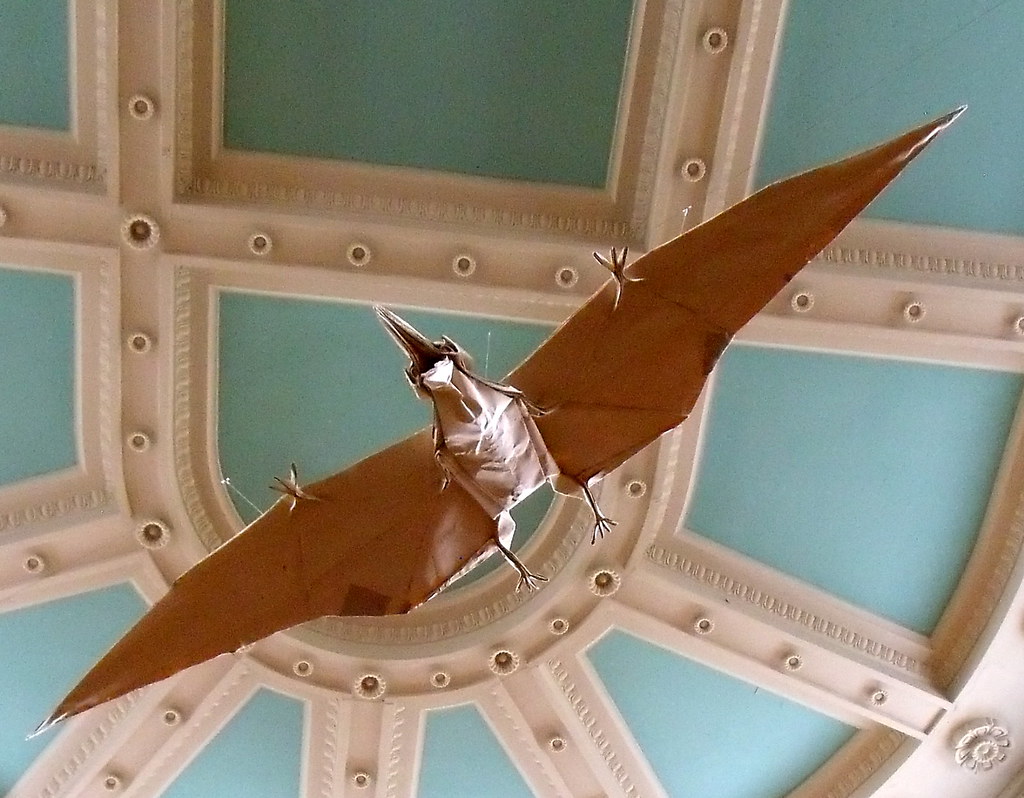
The Redpath Museum opened on September 15, 1882 to house the natural history collection of William Dawson, the long-time McGill Principal and professor. Dawson had been collecting natural history specimens since 1855, and the museum provided for much needed facilities for botanical, paleontological, geological, and zoological specimens, while supporting the expansion of geological, zoological, and botanical research and teaching. The Museum earned its namesake from Peter Redpath whose donation facilitated its creation.
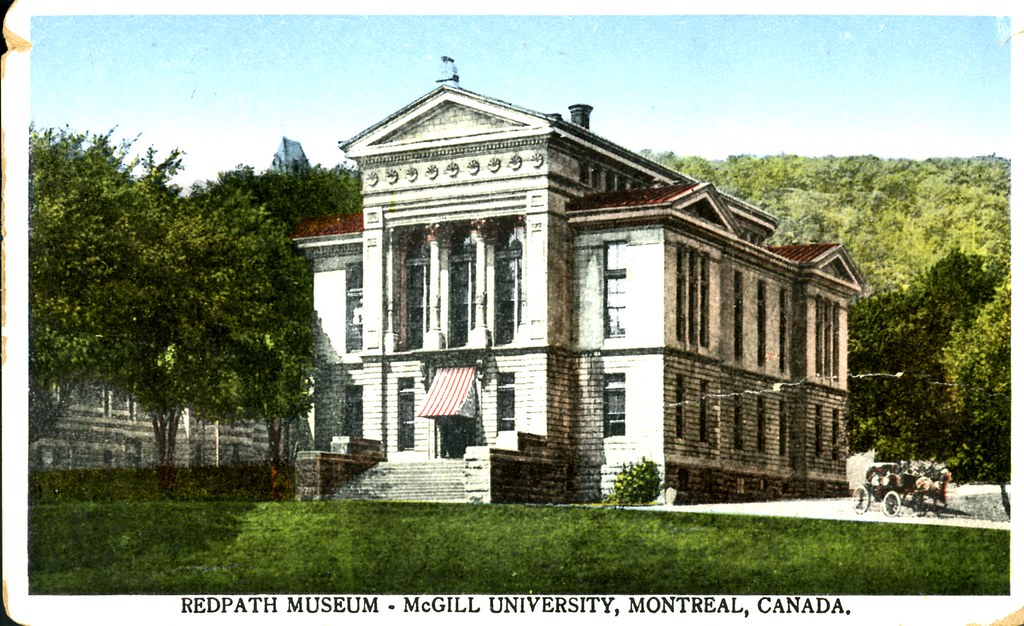
The building was the first purpose-built museum in Canada. Its distinctive architecture, mixing elements of ancient aesthetic styles with iconic columns from modern North American and European sources, is an unusual and late example of the Greek Revival in Canada. Originally, the museum was planned to be used exclusively for research and teaching, but from early on, it was accessed by the public.
The collection of the museum grew over time, thanks to donations from benefactors and acquisitions from personal collections, to cover the areas of paleontology, mineralogy, zoology, and world cultures. The growth of the museum slowed during the war years and Great Depression, and was exacerbated by a new focus on experimental biology and the shift towards research within laboratories in the field of biology. As a result, by the 1950s, the museum shifted its focus to serve primarily as a natural history museum, becoming a fixture for Montreal school children. Due to extreme financial pressure, the museum was closed to the public in the 1970s.
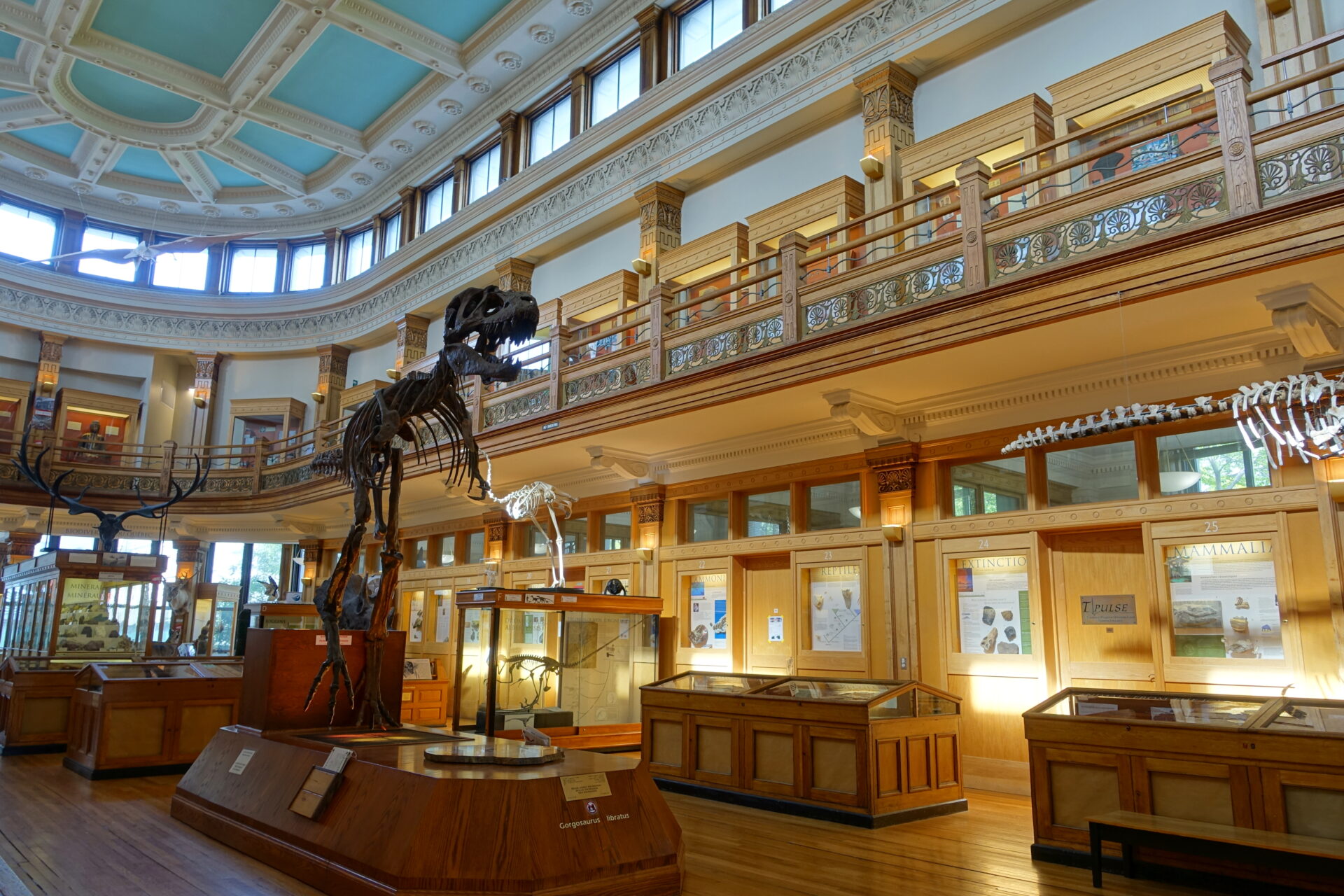
Following its closure, the museum refocused its energies towards research and teaching. In 1986, Redpath reopened its doors to the public while continuing its commitment to scientific endeavors. Since then, the museum has continued to grow by focusing on research and teaching, preserving its collections, and fulfilling a public mandate of education and outreach.
Today, its collection contains over 3 million specimens, including 20,000 mineral specimens from around the world, over 10,000 vertebrate and 14,000 invertebrate specimens, and 17,000 anthropological and ethnological artifacts, covering billions of years of life on planet Earth. It has an exceptional collection of 11,000 fossil plants, harkening back to William Dawson’s original research interests. The museum welcomes numerous school groups each year and maintains a very active outreach program as the only natural history museum in Montreal. It is also an interdisciplinary unit within the Faculty of Science, and provides undergraduate minors and majors, in addition to graduate training in biodiversity, ecology, conversation biology, and evolutionary biology, with six affiliated research laboratories. Drawing on its 140 year history, today the museum facilitates world class research while also welcoming thousands of curious visitors a year, carrying forward the legacy of Dawson’s original commitment to scientific discovery.
Gault Nature Reserve
1958-present
The Gault Nature Reserve serves as a historical tether that connects both the general public and researchers to a special piece of the natural world.
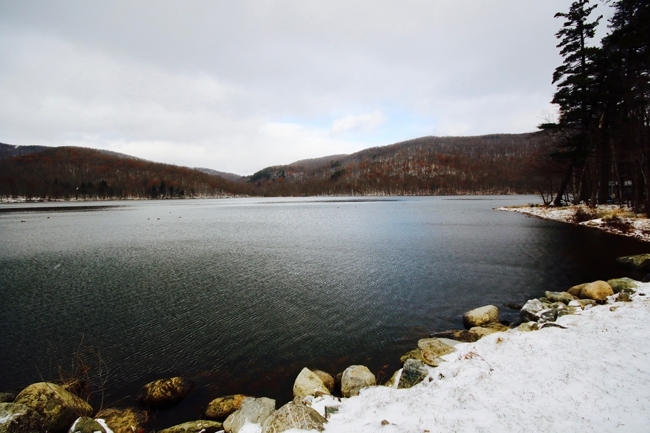
The Gault Nature Reserve, located 30 kilometers east of Montreal in the Monteregie region, encompasses Mont Saint-Hilaire and exists to protect 1000 hectares of some of the last remnants of the primeval forests of the Saint-Lawrence valley. It is home to diverse flora and fauna, as well as rare minerals, some of which are unique to the region.
Mont Saint-Hilaire, called Wigwômandenizibo, meaning small house-shaped mountain in the Abenaki language, has long served as an important place, first by the Algonquin First Nations, whose traditional territory it is situated in. Although its name suggests otherwise, it is actually a large hill, forming part of the Monteregian Hills, an isolated chain of hills between 118 and 133 million years old that run between the Laurentian and Appalachian Mountains. The area of the Nature Reserve was bequeathed to McGill in 1958 by Andrew Hamilton Gault. Gault, a Brigadier-General and British Politician known for raising Princess Patricia’s Canadian Light Infantry during the First World War, had acquired the land himself in 1913. In his own words, he gave the land to McGill so that “its beauties and amenities may be preserved for all time to come, not only to the immediate interests of the university itself, but through its corridors of learning, as a great heritage for the benefit and enjoyment of the youth of Canada.”
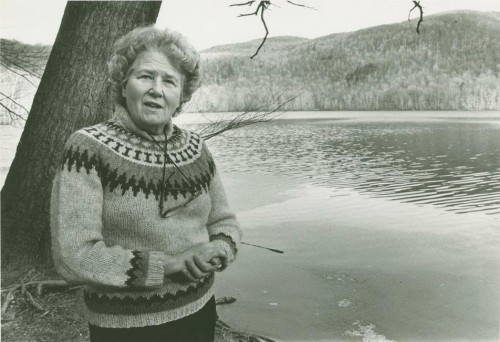
In 1958, the Gault Estate was formally created within McGill, with the land being divided in two. One part of the land was open to the general public and local residents and to be used for recreational purposes, such as hiking. The other section was closed to the public to be preserved for teaching and research at the university. In 1960, it was named a migratory bird sanctuary. In 1972, Alice Johansen, herself a McGill Graduate, was named the Director of the Estate. Under her leadership, the Mont Saint-Hilaire Nature Conservation Centre, a non-profit organization, was created with the intention to promote conservation and education. In 1978, the Gault Estate was designated the first Canadian Biosphere Reserve and was part of UNESCO’s Man and the Biosphere project.
In 2000, the Estate was officially renamed the Gault Nature Reserve to better reflect its focus on conservation. Since then, the Nature Reserve has continued to grow, with the McGill Limnology Research Centre and the Wilder and Helen Penfield Nature Conservatory coming under its direction. The Limnology Research Centre, currently located in Sargent’s Bay, maintains an internationally renowned research program based on studies of the Eastern Townships Lakes. Currently, the Nature Reserve has over 25 kilometers of trails that are open 365 days a year to the public. The Wilder and Helen Penfield Nature Conservatory, located on Lake Memphrémagog, houses wet labs equipped for various kinds of limnological analyses. As well as shoreline, the land attached to the station includes about a square kilometer of forest. Streams, rivers, and more than 30 nearby lakes and ponds offer a wide range of study sites.
It is not only the physical environment of the Gault that makes it a point of interest – it has also been the focus of local lore for centuries. There are many local stories that describe oddities on the Mountain, such as the belief that fairies lived there, or that a white horse appeared each Spring to warn local farmers from planting their crops too early. More recently, it has been described as a hub for UFO activity. While it’s difficult to say what might be attracting extraterrestrial life, the Nature Reserve is a nature gem for researchers and the general public alike.
Science Outreach
1882-Present
Although academic science is often seen as quite separate from society at large, McGill has been fostering public engagement with scientific research and exploring the connections between science and society for many years. This is evident today in the work of the Office for Science and Society, the Office of Science Outreach, the Redpath Museum, the Gault Nature Reserve, and various science outreach student groups in the faculty, but McGill’s history with science outreach stretches back more than 125 years.
A private collection becomes a public icon
McGill’s first foray into public outreach, through the Redpath Museum, was not entirely intentional. The Museum opened in 1882 and was built to hold the natural history collection of William Dawson, McGill’s principal at the time. Originally, the Redpath Museum was intended to be used primarily for teaching and research, but it quickly became a popular attraction to the public. Over time, thanks to donations from benefactors and acquisitions from other collections, the Museum grew to cover the areas of paleontology, mineralogy, zoology, and world cultures.
Celebrities in the service of science
Although many people may be familiar with the connection between Harry Houdini and McGill, they may not know that an exploration of pseudoscience was at its roots. In 1926, Professor William Tait was serving as the Honorary President of the Psychology Society at McGill. In this position, he would invite well known speakers to present at the McGill Student Union. Tait had an interest in challenging pseudoscientific views about psychology, so he invited Harry Houdini, a well-known magician, to speak regarding magic at the Student’s Union. Houdini himself was interested in fostering critical thinking around magic. The event was a great success, with his talk being given to a packed room. It was following this talk that Houdini met two McGill students, Sam Smilovitch and Jack Price, who he invited to the Princess Theatre where he would later be performing. The next day, the two McGill students brought a friend, Jocelyn Gordon Whitehead, along to Houdini’s dressing room. As the well-known story goes, Whitehead asked about Houdini’s strong stomach and delivered several blows to his stomach without warning. Houdini continued his travels but soon started to feel unwell, dying of an appendicitis a few days later. Although it is unlikely that Whitehead’s blows led to Houdini’s death, they have immortalized the connection between Houdini and McGill, which began as a talk that called its attendants to be critical of what they see and hear.
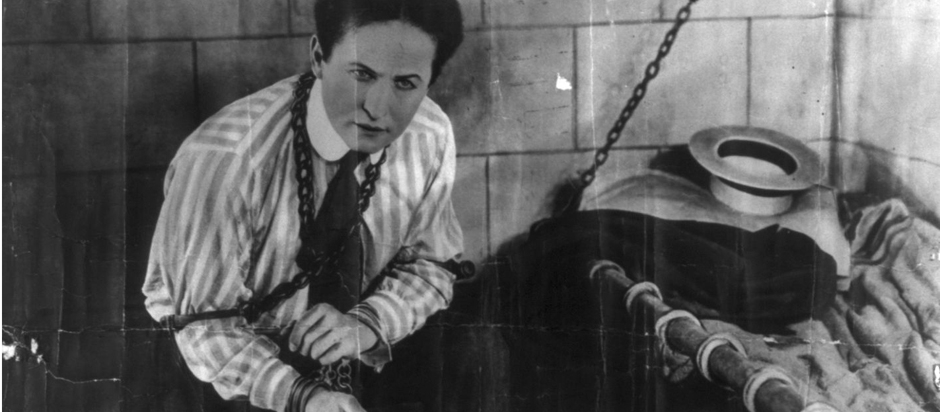
A natural treasure for all
By the 1950s, the Gault Nature Reserve opened as a popular public attraction by McGill. The Nature Reserve, located 30 kilometers east of Montreal in the Monteregie region, encompasses Mont Saint-Hilaire and exists to protect 1000 hectares of some of the last remnants of the primeval forests of the Saint-Lawrence valley. It is home to diverse flora and fauna, as well as rare minerals, some of which are unique to the region. In 1958, the Gault Estate was formally created within McGill, with the land being divided in two. One part of the land was opened to the general public and local residents and could be used for recreational and educational purposes, such as hiking, nature camps, and field trips, while the other section was closed to the public to be preserved for teaching and research at the university. Today, Gault continues to provide this mixture of research and recreation.
Separating sense from nonsense
McGill’s public outreach continued to expand in the 1970s, this time through chemistry. In 1975, Dawson Professors of Chemistry Ariel Fenster and Joe Schwarcz began a stage show called “Magic of Chemistry”, which would go on to have more than 200 iterations throughout North America. Both Fenster and Schwarcz became McGill professors in the 1980s but continued to be involved in public engagement through stage shows and presentations. In 1999, this work was centralized under the Office for Chemistry and Society, later renamed the Office for Science and Society. The Office has a mission to promote critical thinking and responsible science communication. It carries out its mandate through its website, public lectures, and the Lorne Trottier Science Symposium.
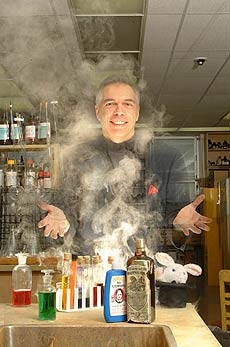
Continuing the outreach tradition into the next century
In 2018, the Faculty established the Office of Science Outreach to support science outreach groups in units such as Chemistry, Earth and Planetary Sciences, Physics, the Integrated Program in Neuroscience and the Redpath Museum, as well as external partners with McGill student members. All of these groups connect schools, community organizations and the general public with science educators and student volunteers to make scientific knowledge more accessible and foster curiosity about science at large. In 2018-19, the science outreach groups reached over 33,000 people in person and more recently, they have been expanding their reach online through innovative programming. The Office helps McGill students strengthen their science communication and teaching skills and promotes critical thinking and science literacy. Science outreach is a valued, intrinsic part of both the undergraduate and graduate experience in the Faculty, while serving the needs of the community for varied, high-quality science programming.
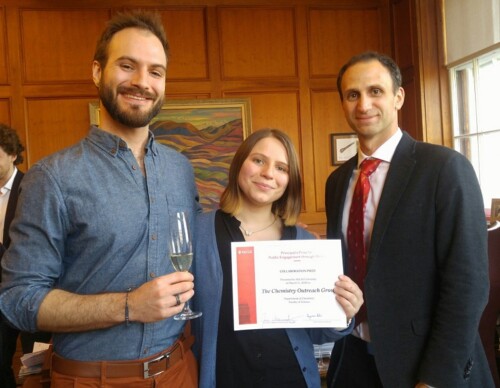
Interdisciplinary Approach, Global Reputation
The Faculty of Science’s departments became more specialized as scientists at McGill and beyond adopted more complex and interdisciplinary understandings of the natural world. The 20th century marked the transition from the mantra of the “solitary genius” to interdisciplinary research teams within and across academic institutions and organizations. The innate intertwining of the goals of universities and government research centers has facilitated hundreds of partnerships between McGill and external research organizations within Canada and across the world. At the student level, the Faculty of Science’s interdisciplinary nature is apparent and encouraged as early as undergraduate studies, with opportunities for cross-disciplinary and international engagement through the Bachelor of Arts and Science degree option, as well as the Bachelor of Science with Global Designation degree option for students broadening their horizons through participation in language classes, independent research, and the inclusion of “real-world” aspects in their program. Departments within the Faculty of Science typically fall within the top 50 of QS and Times Higher Education overall rankings, with the Department of Atmospheric and Ocean Sciences and the Department of Earth and Planetary Sciences in particular, maintaining notably high international rankings in recent years.
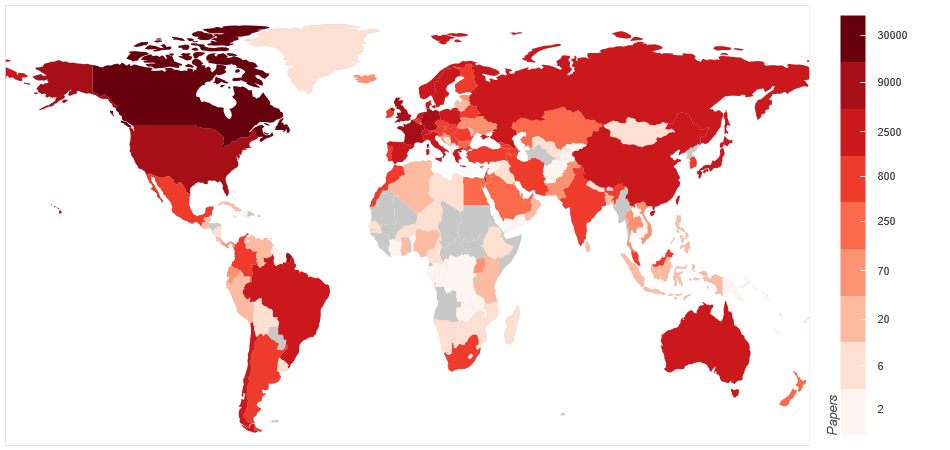
The Convergence of Funding and Interdisciplinary Partnerships
In 2007, Campaign McGill, a $750 million fundraising campaign was launched. Up until this point, McGill and the Faculty of Science had impressively established themselves internationally with limited funding, particularly compared to their globally-established counterparts. The Faculty of Science, amongst other faculties, greatly benefitted from Hydro Quebec’s $10 million donation for scholarships and fellowships in engineering, science, and law; three research chairs in the fields of wind and hydroelectric power, renewable energy, and up-to-the-minute weather forecasting; and seed funding for cutting-edge research in sustainable development law and nano-engineering. The faculty maintains several interdisciplinary partnerships that fuse different departments and other faculties together. To name a few, Centre d’entreprises et d’innovation de Montréal (CEIM) has helped many science start-ups get off their feet, such as Anomera, a company which emerged out of the faculty that converts renewable forest resources into progressive cellulose-based ingredients for cosmetics. Additionally, all pain research is conducted at the Alan Edwards Centre for Research on Pain (AECRP), comprising of researchers from the Faculties of Medicine, Dentistry, and Science to bring together McGill’s basic and clinical pain researchers to promote research that will result in cures for chronic pain. Through activities and international collaborations, AECRP focuses on new discoveries and their clinical applications that will improve the prevention and treatment of chronic pain. In the last decade, the Faculty of Science has strengthened its partnerships with researchers at the Environment and Climate Change Canada (ECCC) to collaborate on forecasting quality, analyses of harmful pollutants, and investigations of the predictability of weather events across Canada, and new units such as the Bieler School of the Environment and the McGill Space Institute have emerged to bring together researchers, including students, from across departments and faculties.
Research Hubs with Global Reach
The Faculty of Science has campus facilities for learning and research that are complemented by field stations around the globe, as well as international exchange and field research programs. One such program is the urban field studies course, which offers opportunities for geographical research in urban public and semi-public spaces, with a demonstration of techniques of mapping, sampling, measurement, photography, and interviewing. There is additionally the Bellairs Research Institute in Barbados, Canada’s only teaching and research facility in the tropics, and one of McGill’s International Strategy Areas of Interest within the Circumpolar region, where the faculty’s MARS and MSARS are stationed. MARS and MSARS host international users like NASA and the Polar Continental Shelf Project.
International Partnerships and Recognition
Over the past decades, we have witnessed the emergence of several partnerships between McGill and other international institutions. For instance, global partnerships with the Weizmann Institute of Science, Tel-Aviv University’s Sackler Faculty of Medicine, and Bar-Ilan University span cancer research, astrophysics, evolutionary biology, major biomedical research, as well as epigenomic research into how exposure to drugs, foods, and physical and emotional trauma affect the brain and the genome. Moreover, McGill and RIKEN, Japan’s largest comprehensive research institution, are also in the process of establishing a joint research center to strengthen opportunities for convergence in nanotechnology, green chemistry, and advanced biomedical sciences. Finally, amongst other partnerships, McGill also joined a research agreement with the Neuroscience Zurich Centre (ZNZ) and Oxford University for research initiatives on topics related to neuroscience.
Image Gallery
Click on the photos to advance through the slideshow.
[rev_slider alias=”science-era-4″][/rev_slider]
